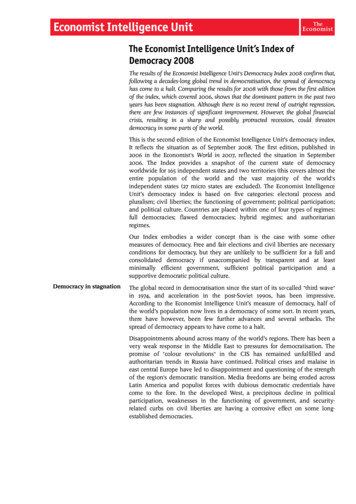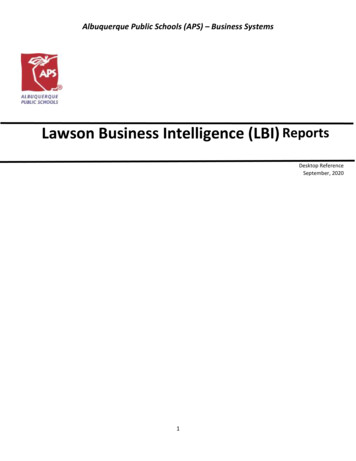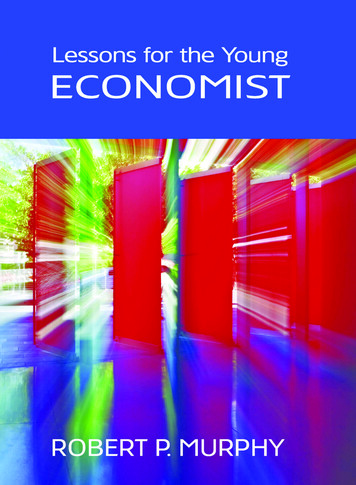
Transcription
The Economist Intelligence Unit’s Index ofDemocracy 2008The results of the Economist Intelligence Unit's Democracy Index 2008 confirm that,following a decades-long global trend in democratisation, the spread of democracyhas come to a halt. Comparing the results for 2008 with those from the first editionof the index, which covered 2006, shows that the dominant pattern in the past twoyears has been stagnation. Although there is no recent trend of outright regression,there are few instances of significant improvement. However, the global financialcrisis, resulting in a sharp and possibly protracted recession, could threatendemocracy in some parts of the world.This is the second edition of the Economist Intelligence Unit’s democracy index.It reflects the situation as of September 2008. The first edition, published in2006 in the Economist's World in 2007, reflected the situation in September2006. The Index provides a snapshot of the current state of democracyworldwide for 165 independent states and two territories (this covers almost theentire population of the world and the vast majority of the world'sindependent states (27 micro states are excluded). The Economist IntelligenceUnit’s democracy index is based on five categories: electoral process andpluralism; civil liberties; the functioning of government; political participation;and political culture. Countries are placed within one of four types of regimes:full democracies; flawed democracies; hybrid regimes; and authoritarianregimes.Our Index embodies a wider concept than is the case with some othermeasures of democracy. Free and fair elections and civil liberties are necessaryconditions for democracy, but they are unlikely to be sufficient for a full andconsolidated democracy if unaccompanied by transparent and at leastminimally efficient government, sufficient political participation and asupportive democratic political culture.Democracy in stagnationThe global record in democratisation since the start of its so-called "third wave"in 1974, and acceleration in the post-Soviet 1990s, has been impressive.According to the Economist Intelligence Unit’s measure of democracy, half ofthe world’s population now lives in a democracy of some sort. In recent years,there have however, been few further advances and several setbacks. Thespread of democracy appears to have come to a halt.Disappointments abound across many of the world’s regions. There has been avery weak response in the Middle East to pressures for democratisation. Thepromise of "colour revolutions" in the CIS has remained unfulfilled andauthoritarian trends in Russia have continued. Political crises and malaise ineast central Europe have led to disappointment and questioning of the strengthof the region's democratic transition. Media freedoms are being eroded acrossLatin America and populist forces with dubious democratic credentials havecome to the fore. In the developed West, a precipitous decline in politicalparticipation, weaknesses in the functioning of government, and securityrelated curbs on civil liberties are having a corrosive effect on some longestablished democracies.
2The slowing of democratisation and rising disenchantment with the results ofsome political liberalisations appear to have a variety of causes. The pace ofdemocratisation was bound to slow after "the easy cases"—eager-to-liberaliseeast central Europe after the fall of the Berlin Wall and African regimessusceptible to outside pressure for political change. "Hard cases" such as Chinaand Middle East autocracies were always going to be a more difficultproposition. Autocrats have also learned how better to protect themselves;many of them preside over energy-rich states and have been strengthened bysustained high oil prices.A key factor is the delegitimation of much of the democracy-promotion agenda,which has become associated with an internationally very unpopular USpresident and military intervention. A combination of double standards inforeign policy (autocrats can be good friends as well as foes) and growinginfringements of civil liberties has reduced the effectiveness of Westerngovernments' calls for democratisation.Although almost half of the world's countries can be considered to bedemocracies, the number of "full democracies" is relatively low (only 30); 50 arerated as "flawed democracies". Of the remaining 87 states, 51 are authoritarianand 36 are considered to be "hybrid regimes". As could be expected, thedeveloped OECD countries dominate among full democracies, although thereare two Latin American, two central European and one African country, whichsuggest that the level of development is not a binding constraint. Only twoAsian countries are represented: Japan and South Korea.Table 1Democracy index 2008 by regime typeCountries30% of countries18.0% of worldpopulation14.4Flawed democracies5029.935.5Hybrid regimes3621.615.2Authoritarian regimes5130.534.9Full democracies"World" population refers to total population of the 167 countries that are covered. Since thisexcludes only micro states this is nearly equal to the entire actual estimated world population in2008.Source: Economist Intelligence Unit; CIA World FactbookHalf of the world’s population lives in a democracy of some sort, although onlysome 14% reside in full democracies. Despite the advances in democracy inrecent decades, more than one third the world’s population still lives underauthoritarian rule.Democracy and developmentThe relationship between the level of development (income per head) anddemocracy is not-clear cut. There is an apparent association; the simplecorrelation between our democracy index for 2008 and the logarithm of GDPper head (at PPP US ) in 2007 is just under 0.6. This may look even surprisinglylow—it implies that in a simple two-variable regression of the democracy indexon income per head, just over one third of the inter-country variation indemocracy is explained by income levels. If we also control for oil wealth (with
3a so-called dummy variable that takes a value of 1 for major oil exportingcountries and 0 otherwise), the explanatory power of the regression risessharply to just over 60% of the inter-country variation in the democracy index.Although this still leaves almost 40% of the variation unexplained, it illustratesthe often-observed strong negative impact on democratic development of areliance on oil wealth.However, the direction of causality between democracy and income is alsodebateable. The standard modernisation hypothesis that economicdevelopment leads to, and/or is a necessary pre-condition for democracy, is nolonger universally accepted. Instead it has been argued that the primarydirection of causation runs from democracy to income (Rigobon and Rodrik2005; Acemoglu et al 2005).One advantage of our index compared to others is that it provides forconsiderable differentiation of scores, including among developed countries.The "near-perfect democracy" is Sweden, the country with the highest score.The other Nordic countries also have high ranks. By contrast, the US and UK arenear the bottom of the full democracy category. In the US there has been aperceptible erosion in civil liberties related to the fight against terrorism.Longstanding problems in the functioning of government have also becomemore prominent. In the UK there has also been some erosion of civil liberties,but there the main feature is a decline in political participation that has been ofshocking proportions. According our index, the UK political participation scoreis the lowest in the developed West and is reflected across all dimensions—voting turnout, membership of political parties, willingness to engage in andattitudes to political activity.These results seem to highlight the interesting hypothesis that large countries,other things equal, tend to be less democratic. But this appears to be the caseonly among the developed countries. It does not hold across the wholesample—there is no significant relationship between the value of thedemocracy index and size of population for the entire 167-country sample.Looking at the regional distribution of regime types, flawed democracies areconcentrated in Latin America and Eastern Europe, and to a lesser extent inAsia. Despite progress in Latin American democratisation in recent decades,many countries in the region remain fragile democracies. Levels of politicalparticipation are generally very low and democratic cultures are weak. Therehas also been significant backsliding in recent years in some areas such asmedia freedoms.Much of eastern Europe illustrates the difference between formal andsubstantive democracy. The new EU members from the region have prettymuch equal levels of political freedoms and civil liberties as the old developedEU, but lag significantly in political participation and political culture—areflection of widespread anomie and weaknesses of democratic development.Only two countries from the region—the Czech Republic and Slovenia (just)—arein the full democracy category. Hybrid and authoritarian regimes dominateheavily in the countries of the former Soviet Union, as the momentum towards"colour revolutions" has petered out.Most of the world's authoritarian regimes are to be found in the Middle Eastand Africa, although there is also a fair number in Asia. The dearth of
4democratic regimes in the Middle East and North Africa is a well-knownphenomenon, with much debate about the causes. In the statistical relationshipbetween democracy and income discussed above, a dummy variable for theMiddle East and North Africa is negative and highly significant statistically evenwhen oil wealth is controlled for in our 167-country sample—that is, Middle Eastand North Africa has much lower levels of democratisation than could beinferred on the basis of income levels. Similar variables for Asia and for EasternEurope are also negative, although at much lower levels of statisticalsignificance. For other regions—Sub-Saharan Africa, Western Europe and LatinAmerica—average levels of democratic development correspond to what wouldbe expected on the basis of average income levels.Table 2Democracy Index 2008IElectoral processand pluralismCategory scoresIIIIIFunctioning reVCivil nland69.2510.0010.007.788.759.71New 9.589.297.789.389.71Full 118.759.41United States188.228.757.867.228.758.53Czech 88.216.117.509.41United Costa Rica278.049.588.216.116.889.41South 6.678.139.12Slovenia307.969.587.866.676.888.82
5Table 2 continuedDemocracy Index 2008IElectoral processand pluralismCategory scoresIIIIIFunctioning reVCivil libertiesRankOverallscoreFlawed democraciesSouth 35.006.259.71Taiwan337.829.587.506.675.639.71Cape .239.585.716.115.639.12Timor-LesteTrinidad na566.638.755.005.565.638.24Sri olombiaPapua uay666.408.336.075.004.388.24El .76Peru706.318.754.295.565.007.94
6Table 2 continuedDemocracy Index 2008IElectoral processand pluralismCategory scoresIIIIIFunctioning reVCivil .067.336.434.445.636.47Hybrid 35.88Hong KongPalestinianterritoriesBosnia 03.334.383.53
7Table 2 continuedDemocracy Index 2008IElectoral processand pluralismCategory scoresIIIIIFunctioning reVCivil .506.47Gambia1114.193.004.644.445.633.24Sierra 3.213.893.135.88Kyrgyz thoritarian 213.713.003.571.675.005.29Burkina 41Côte .863.335.002.06SudanUnited 5Vietnam1492.530.834.291.674.381.47
8Table 2 continuedDemocracy Index 2008IElectoral processand pluralismCategory scoresIIIIIFunctioning reVCivil lic 992.080.002.781.883.24Saudi ArabiaCentral 004.383.24North Korea1670.860.002.500.561.250.00Changes between 2006 and2008The Economist Intelligence Unit’s measure for 2008 reflects a picture of overallstagnation in democratisation since 2006—what Diamond (2008) has called a"democratic recession". Although there is, contrary to some alarmist reports, norecent trend of outright regression, there are very few instances of significantimprovement. The average global score for 2008 is almost unchanged comparedwith 2006, and in most regions the average score for 2008 is similar to theaverage recorded for 2006.There were more countries (68) that had deterioration in their democracy scoresbetween 2006 and 2008 than those that experienced an improvement (56),with the scores unchanged for the remaining 43 countries. The average score forthe 167 countries improved slightly from 2006 to 2008, from 5.52 to 5.55. Inalmost all the world’s regions the average regional score remained unchangedor improved only slightly between 2006 and 2008. The sole exception waseastern Europe, which had a perceptible decline in its average score, although inno country was the change large enough to precipitate a change in the regimetype categorisation. However, 19 out of the 28 countries in eastern Europerecorded a decline in their democracy scores between 2006 and 2008; in onlyone country in this region (the Czech Republic) was there a slight improvement;and in eight the score remained unchanged.
9In only 12 countries out of the 167 that are covered was there a change inregime type between 2006 and 2008—in eight there was a positive upgradingand in four a regression. All four countries that had negative change in regimetype involved a movement from flawed democracies to hybrid regimes(Bangladesh, Hong Kong, Mali and the Palestinian Territories). Among theimproving countries two moved from the flawed to the full democracycategory (Italy and South Korea); two from a hybrid regime to a flaweddemocracy (Nicaragua and Thailand); and four from authoritarian to hybridregimes (Bhutan, Nepal, Pakistan and Sierra Leone).Eight of the 12 countries undergoing a change in regime type were from Asia(three in a negative and five in a positive direction). This illustrates the fact thatmany of the most significant changes in democratisation between 2006 and2008 occurred in Asia, as well as the fact that the trend in Asia was mixed, withboth positive and negative changes almost equally represented.The strengthening of extreme political parties and anti-immigrant forcesunderpinned the deterioration in the scores of several West European countries,including Austria and the Netherlands. As noted, most countries in easternEurope experienced a decline in their scores. A common explanation for theemergence of political difficulties in east central Europe is that the EU accessionprocess had previously held together these countries' fractious party politicalsystems, as mainstream parties united behind the reforms that were needed togain EU membership. But once accession was achieved, and politics reverted to"natural" antagonistic patterns, the underlying fragility of east-central Europeanpolitical systems was exposed.There are a number of possible reasons for this fragility. Most important is thatalthough democratic forms are in place in the region, the substance ofdemocracy—including a political culture based on trust and healthy levels ofpolitical participation—is absent. This is manifested in low levels of politicalparticipation beyond voting (and even turnout at elections is low in somecountries), and very low levels of public confidence in state institutions. A keyunderlying factor is that transition has resulted in a large stratum ofdiscontented voters, who feel that they have lost out during the transition, andwho as a result often favour parties that would challenge the status quo.Ukraine which suffered only a small deterioration in its score between 2006and 2008, remains, along with Moldova, the only democracy in the CIS (albeitin the flawed category). The most significant declines in score between 2006and 2008 were recorded in Georgia and Russia (the third biggest declineworldwide was in Russia). The so-called "rose revolution" in Georgia, whenpeaceful street protests against falsified parliamentary elections in November2003 eventually forced out the incumbent president, Eduard Shevardnadze,created optimism that the country would move towards a democracy.Subsequent events have not justified these hopes. Constitutional amendmentswere pushed through in 2004, concentrating power in the hands of the newpresident, Mikheil Saakashvili, and weakening the legislature. In 2006, thegovernment manipulated the electoral system for local elections, ensuring thatthe ruling party would dominate local legislatures. A crackdown on theopposition and a nine-day state of emergency imposed in November 2007
10illustrated the lack of progress. The conduct of elections in 2008 left much to bedesired. Finally, Mr Saakashvili's attempt to reintegrate by force Georgia'sbreakaway region of South Ossetia in August 2008 led to conflict with Russiaand disaster for Georgia.Table 3Democracy across the regionsNumber of countriesNorth America20062Democracy indexaverageFull rianregimes8.64200028.642000West Europe2006218.60182102008218.6119110Eastern Europe2006285.76214662008285.68214662008Latin America & the Caribbean2006246.37217412008246.4321831Asia & 52220061675.522854305520081675.5530503651Middle East & North AfricaSub-Saharan AfricaTotalIn Russia, the one positive development (the fact that the Constitution wasrespected and that Vladimir Putin stepped down from the presidency in May2008) was offset by a number of negative developments. Although the formaltrappings of democracy remain in place, today's Russia has been called a"managed" (or "stage managed") democracy. The Duma is now little more thana rubber-stamp parliament; regional governors are appointed directly; the mainmedia are state-controlled; civil society organisations have come under intensepressure; and the state has increased its hold over the economy. Most Russiansappear unperturbed by the trend towards authoritarianism. During thepresidency of Boris Yeltsin, many Russians came to associate the term"democracy" with chaos, and "capitalism" was synonymous with riggedprivatisations, the rise of the "oligarchs" and widespread poverty.There was little change in the overall situation in sub-Saharan Africa. Twentycountries had a decline in the scores between 2006 and 2008 (many of themfrom already very low levels); 16 had an improvement and for eight the scores
11remained unchanged between 2006 and 2008. Two underwent a regimechange: a small deterioration was sufficient to push Mali out of the flaweddemocracy category into a hybrid regime, and Sierra Leone showed majorimprovements, lifting the country out of the authoritarian category.There were few changes between 2006 and 2008 in Latin America (onepositive change in regime type) and the Middle East and North Africa (onenegative change in regime type), where almost all countries remainauthoritarian.Shifts in regime typeDowngradesBangladesh—from flawed democracy to hybridBangladesh has been governed by a caretaker government, under emergency rule,since January 2007. The normal practice in Bangladesh is for the outgoinggovernment to transfer power to an unelected caretaker government, which ischarged with preparing for parliamentary elections. This transfer of power occurredin October 2006, but owing to disagreements over the preparations and adeteriorating security situation, emergency rule was promulgated on January 11th2007. Street protests are banned, (although restrictions on protests might be lifted inthe coming months).Hong Kong—from flawed democracy to hybridSeveral developments underpin the deterioration in Hong Kong. One was thedecision of the Chinese government to rule against the introduction of fulldemocracy until 2017 (at the earliest). There have also been increasing reports of selfcensorship in the local press owing to fears that newspapers that print negativestories about China and the Hong Kong government will lose advertisingopportunities from Chinese and HK companies.Mali—from flawed democracy to hybridThere has been a deterioration in civil liberties as the government has restrictedmedia freedoms, while insecurity has increased as a result of insurgency in the northof the country.Palestinian Territories—from flawed democracy to hybridThe Islamist Hamas movement that won the parliamentary election in early 2006,and Fatah, who hold on to the presidency have failed to bridge their differences.Instead, factional infighting has worsened in recent years, culminating in thetakeover of power in the Gaza Strip by Hamas while the Palestinian president,Mahmoud Abbas, of Fatah has tried to maintain his grip on the West Bank. Politicalviolence has worsened.UpgradesBhutan—from authoritarian to hybridThe secluded nation has made major progress in its transition from absolutemonarchy to democracy. Elections have been held for both houses of parliament, inDecember 2007 (for the upper house of parliament) and March 2008 (for the lowerhouse of parliament).Italy—from flawed to full democracySilvio Berlusconi controlled the state broadcaster at the 2006 election, but this is nolonger the case. Mr Berlusconi won the most recent election, but this was in a fair
12vote. There has been some improvement in checks and balances and in ensuringthat all parties have equal access to the media during an election campaign.Nepal—from authoritarian to hybridBetween late 2006 and now, Nepal has seen the signing of a comprehensive peaceagreement that ended a decade-long Maoist insurgency; the inclusion of the Maoistformer rebels in a coalition government; and the holding of a parliamentary election.Nicaragua—from hybrid to flawed democracyRecent elections have been clean; legislative politics have become more constructivewith the opposition, previously divided, increasingly finding a united voice andbecoming effective at limiting the government's excesses; and the Supreme Court hasenacted a constitutional reform that limits the power of the executive.Pakistan—from authoritarian to hybridIn November 2007 the then-president, Pervez Musharraf, relinquished his position asarmy chief, thus removing the last official vestige of army rule. The state ofemergency that was imposed in late 2007 was short-lived. In February 2008 thecountry successfully held a parliamentary election whose results were accepted, anda coalition government was formed.Sierra Leone—from authoritarian to hybridThe country held reasonably free and fair general elections in 2007, with fewincidents of violence. There was an orderly transfer of power to the opposition.These were the first elections held after the withdrawal of UN troops.South Korea—from flawed to full democracyImprovements in civil liberties and a further reduction in any residual risk of areturn to military rule underpin the move to the full democracy category.Thailand—from hybrid to flawed democracyAfter staging a coup in September 2006 to oust the democratically elected primeminister, Thaksin Shinawatra, the military kept its pledge to hand power back to acivilian government via a fresh election. The December 2007 election went aheadsmoothly, and a new government was installed soon after with a workable majorityin the House of Representatives (the lower house). The military has since returned tothe barracks. However, ongoing political instability means that there is a considerablerisk that the military could again intervene and oust a democratically-electedgovernment.Democracy under stressThere have been major reversals before—a democratisation wave after theSecond World War ended with more than 20 countries subsequently slidingback to authoritarianism. We are not yet witnessing that sort of rollback, but thethreat of backsliding now outweighs the possibility of further gains.Democracy as a value retains strong popular appeal worldwide. Surveys showthat most people in most places still want democracy. While creatingdemocracy by external intervention is being discredited, trends such asglobalisation, increasing wealth and education, and expanding middle classeswould normally favour the organic development of democracy. Theseunderlying forces suggested that any retreat from democracy would not bepermanent.However, this is where the present global financial crisis and likely sharp andpossibly protracted recession in much of the world enters the picture. The crisishas the potential to undermine the credibility of free-market capitalism,
13especially in lower income markets. The Economist newspaper recentlyconcluded that "economic liberty is under attack and capitalism, the systemwhich embodies it, is at bay." (Economist, October 18-24). The UK, the birthplaceof m
This is the second edition of the Economist Intelligence Unit’s democracy index. It reflects the situation as of September 2008. The first edition, published in 2006 in the Economist's World in 2007, reflected the situation in September 2006. The In










